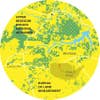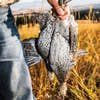The Native Bird: Chasing Sharptails on BLM Land in Montana
Even when conditions are brutally hot and flushes are sparse, a sharptail hunt on public land is a total rush


I’ve been at it for decades now, every September, somewhere on the public lands of central or eastern Montana—incandescent sunlight, the prairies toasted to the color of an elk hide, and the heart-pounding explosion of a sharptail launching skyward from cover. It is always new, even if you’ve hunted the prairies a thousand days, been clawed by the same buffalo berry, stumbled in the hard-dried mud of the same steep cattle trails, turned your face into the same winds that define the American grasslands like no other force of nature can. Today is no different, this first afternoon of a three-day adventure in central Montana. I’m watching my buddy Doug Krings’s new pup, a whippet-thin Llewellin setter named Rocket, discover her life’s work, right here on this blazing-hot afternoon when saner folks, and saner dogs, would be shaded up or fishing a spring creek somewhere. Not for us the shade. We’re here to hunt. We flank Rocket, and the birds flush, hurtling through space, down and away to a set of coulees below. I hear Krings shoot, but I’m so rattled at the suddenness of it all that I hesitate and miss my chance. A late flusher erupts behind me, and I pivot and swing, beyond thought, only intention and muscle memory, and the bird tumbles in a puff of feathers. I never even heard my own shot. It was the late Jim Range, cofounder of the Theodore Roosevelt Conservation Partnership (TRCP), who taught me to revere sharptails as perhaps our ultimate native gamebird. Range was a hard-cussing, indefatigable Tennessean who loved our Western prairies and had, over decades of carefully focused rambling, developed a unique mental map of where his favorite gamebirds could be found, usually on public lands, in the farthest out-of-the-way corners of Montana, Wyoming, and the Dakotas. He opened the crops of the birds we killed, marveling at the beauty of what they lived on. “Look at this,” he’d say. “Serviceberry, chokecherries, rose hips—sharptails are American natives in every fiber of their being, and every damn thing they eat is perfectly beautiful.”

So it was fitting that for our second day of chasing sharptails, Krings and I were joined by my old friend Scott Laird, now working for the very same TRCP. Laird and I had driven to Lewistown from points west, emerging from the viscous wall of smoke produced by one of Montana’s most spectacular and devastating wildfire seasons. Central Montana’s public lands were smoky, too, but by orders of magnitude less than the ones I had been hunting near my hometown at the edge of the Rockies. We set off from the trucks, a merry and optimistic band, four dogs running ahead, on a vast expanse of public land managed by the federal Bureau of Land Management.

The country was parched and less than thick with gamebirds. In the shimmering distance, never seeming to get any nearer, two small willows marked a water hole. The heat bore down upon us like a man trying to squash a tick with the flat of his thumb. We walked. The dogs ran. When at last the dogs stumbled over a small covey of sharptails, the birds flushed wild and far away. I pondered the coulee where they disappeared and could not muster the mojo to pursue them. Luckily for the dogs, the willows and the water hole were no mirage. The German wirehairs wallowed in the slime, breaking through the crusts of white alkali to greedily lap water that would have sent a man into fatal gastrointestinal meltdown. A beautiful red-sided garter snake swam lazily between the dogs. A painted turtle rose to the surface. We discussed whether there could be any strange, tougher-than-the-apocalypse native fish in the hole. We returned, not talking to save energy, arrived at the trucks birdless, and spent the gloaming hours drinking beer and combing the sticktights of hound’s-tongue and burdock from the mud-armored fur of the dogs. That is just the way it goes, sometimes, and there are far worse ways to spend one of the days allotted us here on this fine earth.

Game Time
The third and last day was kind to us. Krings was able to get the day off work, and he showed up early with Rocket, an old Remington 870, and a GPS, on the search for new public-land holy grails. We were joined by another local, Don Thomas, and his German wirehairs, Max and Maggie, all of them, dogs and man, seasoned pros with enough youth left in them to drive hard all day long.
This new country showed up on our GPS as the pale yellow of BLM land, not as vast as that we’d been skunked upon the day before, but this public space immediately struck us all as full of promise and power: A long roll of prairie hillside was cut with deep coulees packed with buffalo berry, chokecherry, and hawthorns big and mean-thorned enough to wall in and shade trickles of live water, even in September, even after 50 days of heat and no rain. The place was rich, profoundly beautiful and, as seems to be the nature of the best of the sharptail habitat in these parts, very, very steep. And after a decent period of struggle, we found game.

The first birds erupted from a patch of serviceberry and snowberry grazed by cattle and stunted by harsh winds to less than waist-high. We killed a couple and put them in our vests where they hung, dense like sacks of gold. The rest of the covey wheeled and whirled down into the thickets. As we ran downhill to try and keep up with the dogs, I could feel the sweat start under my daypack and trickle down my spine. The sharptails landed in the brush and, as the wiliest ones do, set off running. We lost them in there. Searching for a path through, I stopped to eat a handful of yellow wild currants from a bush lost in a tangle of hawthorn. I remember Jim Range telling me, all those years ago, how little it took to have thriving populations of tough birds like sharptails—just a little water, a little respect for the native plants, leaving some belts of cover and taking decent care of places just like this one. The dark purple chokecherries hanging above me were so thick that the branches drooped under their weight.


I heard somebody shoot twice, and the call of “Dead bird, Max, dead bird!” and I was off again, fast, exhilarated, alive. If there is any adventure that can beat an endless stretch of American public lands, there free for the roaming, and America’s finest wild gamebird, flushing hell-bent against the great yawning skies of the West, I’ve never found it.